Clement Clarke In-Check DIAL G16 User manual

Instructions for Use
Pokyny k použití
Brugsanvisning
Bedienungsanleitung
Instrucciones de uso
Käyttöohjeet
Mode d’emploi
Istruzioni per l’uso
Gebruiksinstructies
Bruksanvisning
Instrukcja użytkowania
Instruções de utilização
Navodila za uporabo
Bruksanvisning
G16
Disposable Inspiratory One-way
Mouthpiece with

How to use the In-Check DIAL G16 kit
Target
Clinically
Effective
Flow Rate
30-90 L/Min
e.g. achieved = 55

1
Caution Consult ‘Instructions for Use’.
This product complies with the essential requirements of the medical devices
directive (93/42/EEC).
Instructions for Use
Introduction
The In-Check DIAL G16 kit is an inhalation airflow training meter system that can help
educate and assess patients who use inhaler devices.
Inhaler devices are designed to deliver medication to the respiratory tract, and the speed of
inhalation through them (the inspiratory flow) can have a significant effect on the quantity
of drug delivered and the clinical efficacy of the product.
The In-Check DIAL G16 kit is designed to simulate the “internal resistance” of common
inhaler devices, and assess inspiratory flow. These assessments enable the healthcare
professional to encourage patients to modify their inspiratory technique (by inhaling with
more, or less effort), in order to achieve a flow rate consistent with clinical efficacy. The
coloured ‘flow’ icons show the clinically effective flow ranges for each different inhaler
device. These ‘flow’ icons do not imply any comparison between devices.
Patients that cannot achieve the suggested inspiratory flow for their inhaler may not gain
maximum benefit from their prescribed medication, and healthcare professionals may wish to
take this factor into account when selecting with the patient, the device that is the most suitable.
Inspiratory Flow and Clinically Effective Flow Range
The inspiratory flow through an inhaler is one of the factors that will influence the clinical
effect of the drug delivery from that device. The most effective delivery occurs when the
patient achieves a flow within the clinically effective flow range. Flow rates outside this
range, may result in a diminished deposition and clinical efficacy.
For further information, see: www.haag-streit.com/clement-clarke
In-Check DIAL G16
is an assessment device that has a selectable resistance from high to low, shown by the
coloured ‘flow’ icons on the back cover of this booklet, calibrated to enable the assessment
of airflow as if the patient was using certain different inhalers.
The “conventional pMDI” position can be used to approximate the resistance when a
conventional pMDI is attached to a holding chamber or spacer device.
When used with the enclosed mouthpiece, In-Check DIAL G16 provides an assessment
of inspiratory flow through five classes of device resistance. However, the resistance is
not precise for all inhalers, e.g. the resistance of the Genuair is slightly lower than the
resistance of the Turbohaler Mk III, but they are both medium resistance inhalers. To mimic
the precise resistance of a particular inhaler, specific adaptors are available to use with the
DIAL set to ‘conventional pMDI’.
Should new types of inhaler become available, then In-Check DIAL G16 kit can be used to
assess the new inspiratory flow, by knowing the resistance of the new inhaler.
IMPORTANT
As with any inhalation device, it is important to check for loose foreign objects before the
device is used to prevent debris entering the mouth/throat. The transparent material used
in the construction of the In-Check DIAL G16 enables the user to make a visual check
before inhalation. Patients should be prevented from exhaling through the device prior to
use to avoid damaging the device.
To Reset the In-Check DIAL G16
Hold the instrument vertically with the mouthpiece uppermost, so that the rounded end of the
meter can be tapped firmly against the other hand or a horizontal surface, such as a table.
This will dislodge the magnetic resetting weight, which will return the red cursor to the
start position. The device must now be turned through 180 degrees to return the magnetic
weight to its resting position.

2
Do Not attempt to reset the In-Check DIAL G16 by shaking/tapping at any other
orientation.
– this action will cause serious damage to the piston and pointer and end the life of
the instrument.
How to use the In-Check DIAL G16 kit - see diagrams
1. Reset the In-Check DIAL G16. See ‘To Reset the In-Check DIAL G16’ section.
2. Align the dial selector with the desired coloured icon – an audible “click” should be heard.
3. Attach a clean mouthpiece. Disposable one-way inspiratory mouthpieces are preferred.
4. Ask the patient to exhale fully.
5. Ask the patient to seal their lips around the mouthpiece. According to the inhaler chosen,
instruct the patient to inhale in the manner recommended by the inhaler manufacturer.
6. Record the inspiratory flow from the position of the red cursor against the scale. Reset,
and repeat two more times, ensuring correct technique each time.
7.
Compare values achieved with target flows for that device. To operate an inhaler device
correctly, the patient should be able to achieve a flow rate within the clinically effective range.
*e.g. Accuhaler: Clinically Effective Flow Rate 30-90 L/Min.
8. If after repeated training the patient is not able to achieve these values, then the healthcare
professional may wish to assess the patient’s ability to use an alternative type of inhaler.
Performance Accuracy
Accuracy +/- 10% or 10 L/min (whichever is the greater) and repeatability of +/- 5 L/min.
Cleaning your In-Check DIAL G16
As the In-Check device is designed for inspiratory flow assessment, the risk of cross-
infection is greatly reduced when compared to an expiratory peak flow meter because
clean air is being sucked in. However, the meter can become compromised if a patient
accidentally blows or coughs into the device.
In an effort to reduce the risk of cross-contamination to its lowest possible level we
recommend the use of the inspiratory one-way valve mouthpieces or Spirometry type
anti-bacterial/anti-viral filters.
Cleaning Methodology
For personal use your In-Check device can be cleaned by immersing the device in warm
(but not hot) mild detergent solution for 2-3 minutes (maximum 5 minutes). Agitate the
meter to ensure thorough cleaning. Rinse in warm water and shake to remove any excess
water. It is important to rinse thoroughly to prevent salt spots appearing on the inside of the
body and the spindle.
To shake excess water from the In-Check device, hold only at the end furthest away from
the device selector.
Allow to dry thoroughly before using again.
For more intensive cleaning/disinfection between patients the In-Check device can also be
cleaned and disinfected using “Steris ProKlenz NpH” or “Rely+On/PeraSafe”.
The In-Check device can be sterilized using the “Low Temperature hydrogen peroxide
plasma - Sterilization System”.
It is important to follow the manufacturer’s instructions and recommended contact times
for the above products.
Cleaning Frequency
The following recommendations for disinfection frequencies are presented as a guide only.
In practice, the person responsible for the clinical wellbeing of the patient should consider
the specific circumstances of the next patient and the risk of infection posed by
cross-contamination.
If used with a one-way valve mouthpiece or anti-bacterial filter the In-Check device should
be cleaned weekly.
If used with an open mouthpiece the device should be cleaned between patients.

3
Interpreting information from the In-Check DIAL G16
In-Check DIAL G16 was modified in January 2016, in response to customer feedback, to
provide information about a wide range of new inhaler devices and the inspiratory flow
rates that are associated with clinical efficacy. The new scale is shown above.
The information provided is for guidance only. It does not imply that any particular product
will be clinically effective. There are other aspects than inspiratory flow that contribute
towards clinical efficacy. The information is based on published clinical studies. In some
cases studies may have been performed on a particular formulation in a specific device
and may be suggestive that other formulations will behave similarly.
DPIs
Laboratory studies demonstrate that DPIs have a degree of flow-dependence, meaning that
delivery may be affected by increasing flow rates. This does not always equate to improved
clinical efficacy. A pale arrow represents the intention that flow rates of a higher level may
be beneficial for DPIs.
pMDIs
The pMDIs have been represented in a single block from 20-60 L/Min because the clinical
studies support this. The pale arrow is pointed in the opposite direction for pMDIs,
indicating that a slower rather than higher flow rate is beneficial in this type of inhaler.
The devices are individually represented on the back cover.
Adaptors (specific device mimics)
These adaptors listed below can be used with the In-Check DIAL G16 :
Turbohaler Mk II - T - 3109781
HandiHaler - H - 3109859
Diskhaler 4 Blister - D4 - 3109788
Clickhaler - C - 3109786
Genuair - G - 3109861
Breezhaler - B/F - 3109783
Easyhaler (M) Monotherapy - EH - 3109787
Accuhaler - A/A/D - 3109822
Set DIAL to the pMDI to use with device specific adaptor.
Part Codes
In-Check DIAL G16 3109300
In-Check Peak Inspiratory Flow Meter (Oral) 3109750
Disposable one-way mouthpieces (Inspiratory, 5 x 20) 3122061
Disposable one-way mouthpieces (Inspiratory, bulk, 200) 3122063
Disposable Cardboard Mouthpieces (Adult, 5 x 20) 3125030
Disposable Cardboard Mouthpieces (Adult, 500) 3122003
Disposable Cardboard Mouthpieces (Child, 500) 3123030
Universal Plastic Mouthpieces (15) 3103095
Adult to Paediatric Mouthpiece Adaptor 3105027
High
Medium High
Medium
Medium Low
Low
pMDI/SMI
Training Device
RESISTANCE
Table of contents
Languages:
Other Clement Clarke Medical Equipment manuals
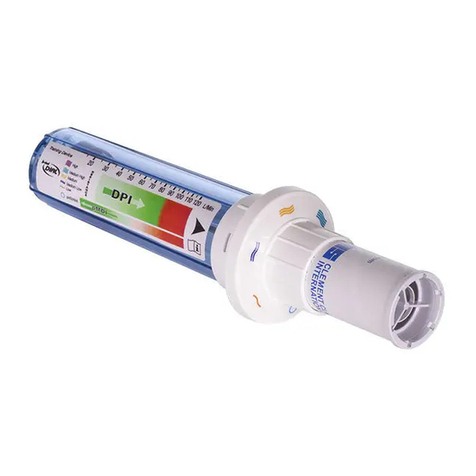
Clement Clarke
Clement Clarke In-Check M User manual
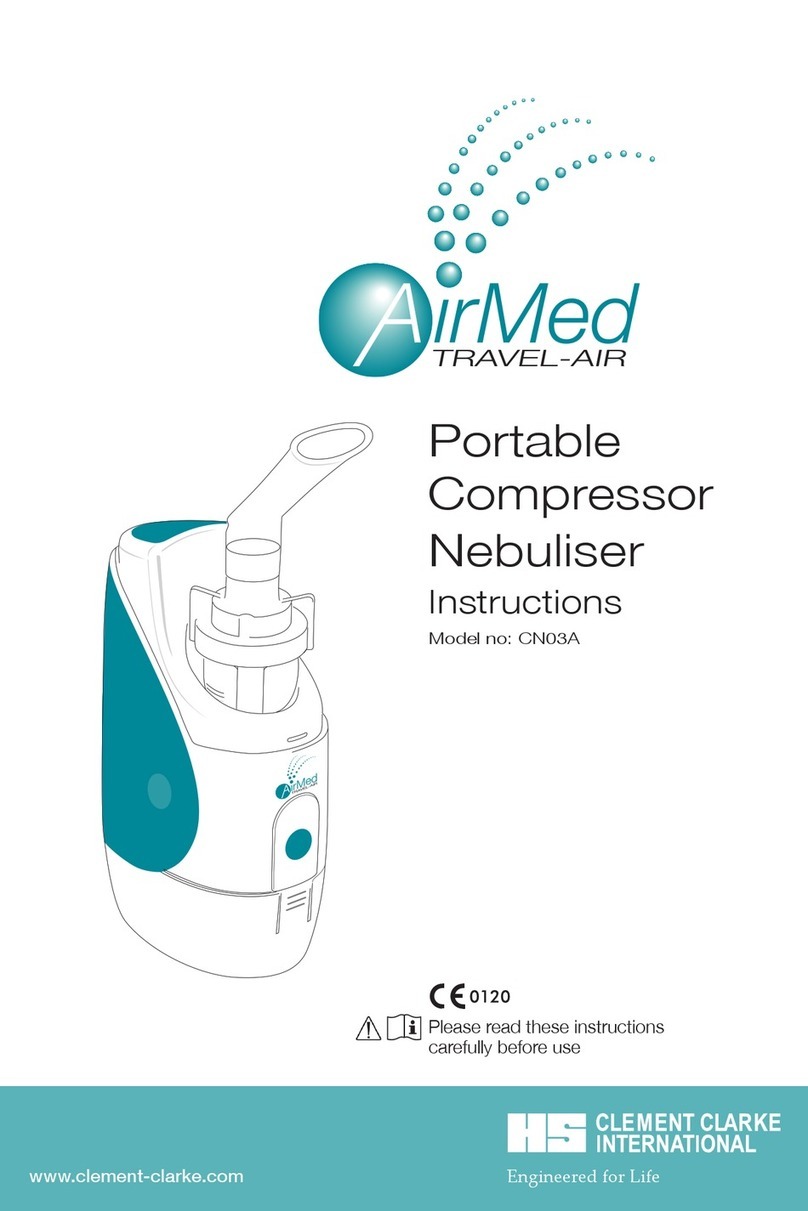
Clement Clarke
Clement Clarke AirMed Travel-Air CN03A User manual
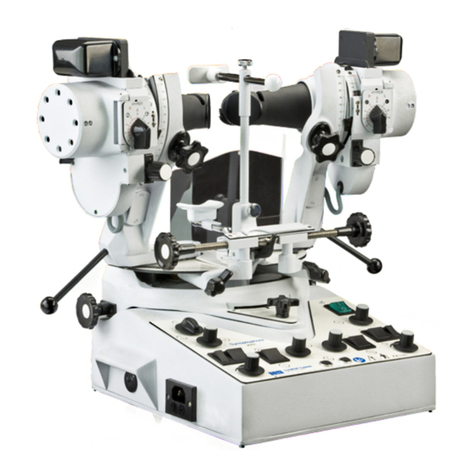
Clement Clarke
Clement Clarke 2001 User manual
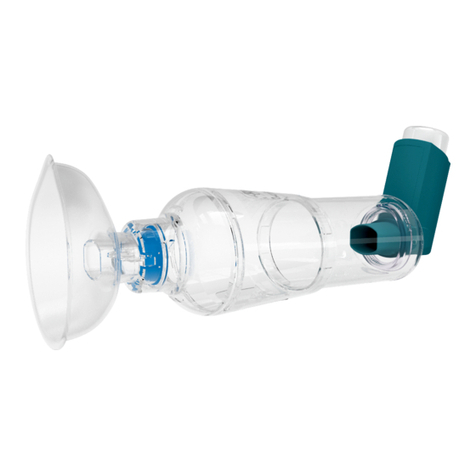
Clement Clarke
Clement Clarke A2A Spacer User manual
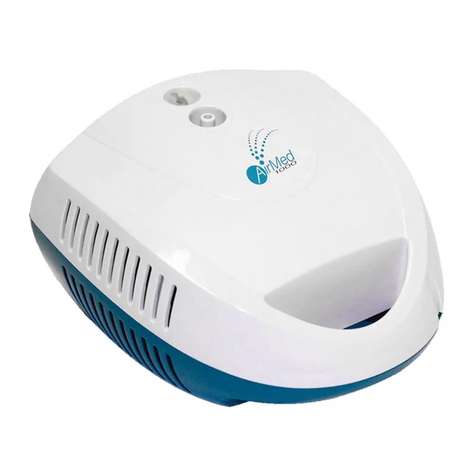
Clement Clarke
Clement Clarke AirMed 1000 User manual
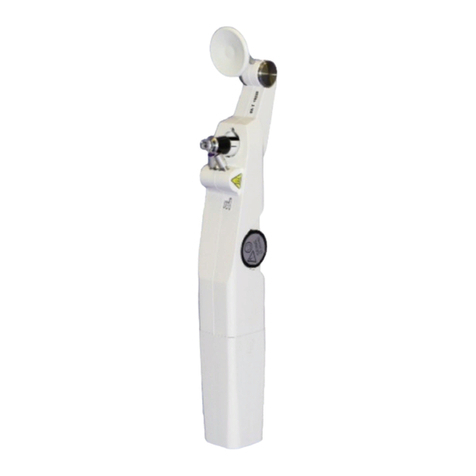
Clement Clarke
Clement Clarke Perkins Mk2 User manual
Popular Medical Equipment manuals by other brands

Getinge
Getinge Arjohuntleigh Nimbus 3 Professional Instructions for use

Mettler Electronics
Mettler Electronics Sonicator 730 Maintenance manual

Pressalit Care
Pressalit Care R1100 Mounting instruction

Denas MS
Denas MS DENAS-T operating manual

bort medical
bort medical ActiveColor quick guide

AccuVein
AccuVein AV400 user manual











